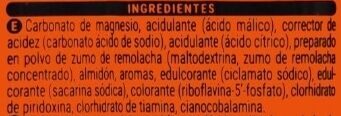Magnesio + Vitaminas B1 B6 B12 sabor Naranja - Deliplus - 3,9 g x 20
Aquesta pàgina del producte no està completa. Podeu ajudar a completar-la editant-la i afegint-hi més dades a partir de les fotos ja disponibles, o fent-ne més amb l'aplicació de androide o iPhone / iPad. Gràcies!
×
Codi de barres: 8480000795946 (EAN / EAN-13)
Nom comú: Complemento alimenticio con magnesio y vitaminas
Quantitat: 3,9 g x 20
Marques: Deliplus
Categories: Suplements dietètics, en:Vitamins
Etiquetes, certificacions, premis: Lliure de gluten
Botigues: Mercadona
Països on es va vendre: Espanya
Matching with your preferences
Salut
Processament d'aliments
Additius
Anàlisi dels ingredients
Entorn
Empaquetament
Transport
Report a problem
Fonts de dades
Producte afegit per kiliweb
Última modificació de la pàgina del producte per tasja.
La pàgina del producte, també editada per antoniocardona, elcoco, halal-app-chakib, openfoodfacts-contributors, roboto-app, rubenping, thaialagata, yuka.ZnFjL0VmNWF0S1l3dFBRLzhqN3QyOG9vNW8rM1ZHaVdEcnM3SUE9PQ.








